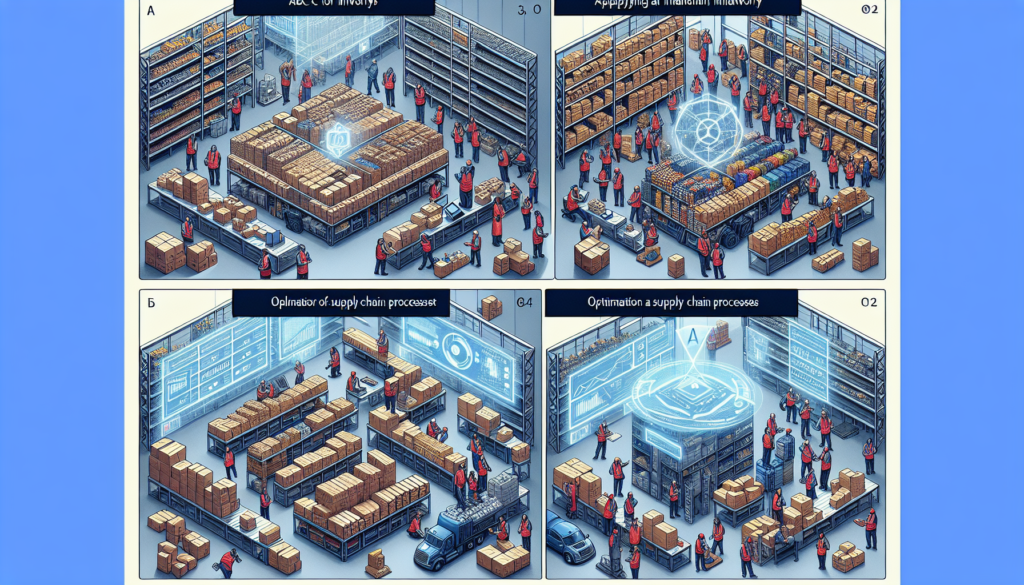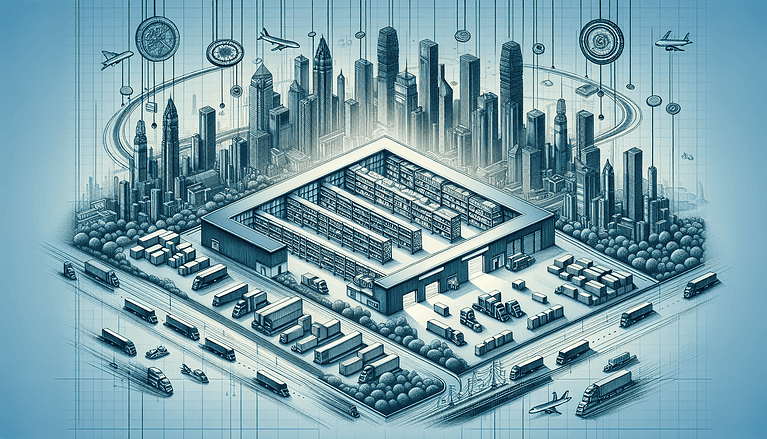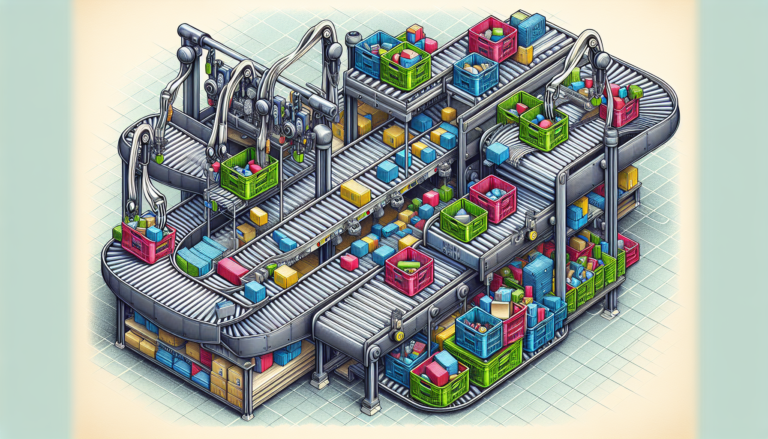Warehouse Layout Optimization: Increase Efficiency by 40%
Imagine slashing your operational costs by a third, doubling your storage capacity, and processing orders 40% faster – all without expanding your warehouse’s footprint. This isn’t a logistics fairy tale; it’s the power of warehouse layout optimization.
Implementing a new warehouse layout is crucial for achieving these benefits, as it involves careful planning, testing traffic flow, training employees, and utilizing tools like digital twins and 3D models for efficient operations and safety.

Table of Contents
Introduction
In the high-stakes world of modern logistics, every square foot of your warehouse space can be the difference between profit and loss. But what if you could dramatically boost your efficiency without expanding your physical space?
That’s where warehouse layout optimization comes in – and it’s revolutionizing how top performers in the industry operate.
Warehouse optimization is the strategic process of redesigning your facility’s physical space and workflow to maximize efficiency, productivity, and profitability. It’s not just about rearranging shelves; it’s about reimagining your entire operation from the ground up.
The impact? Industry leaders report staggering results:
Up to 40% increase in overall efficiency
30% reduction in operational costs
50% improvement in order processing times
25% boost in storage capacity
Whether you’re running an e-commerce fulfillment center, a manufacturing distribution hub, or a third-party logistics operation, optimizing your warehouse layout can be the key to unlocking unprecedented performance.
But here’s the kicker: despite its game-changing potential, many warehouses still operate with outdated, inefficient layouts. If you’re facing challenges like slow order fulfillment, high operational costs, or maxed-out storage capacity, you’re leaving money on the table – and your competitors are taking notice.
In this comprehensive guide, we’ll dive deep into warehouse layout optimization. We’ll explore the key principles that drive efficient designs, walk you through a step-by-step optimization process, and share real-world success stories to inspire your transformation.
From leveraging cutting-edge technologies to implementing tried-and-true strategies, we’ll equip you with the knowledge to turn your warehouse into a lean, mean, profit-generating machine.
Ready to unlock the full potential of your warehouse space? Let’s explore how you can optimize your layout for maximum efficiency and profitability.
The Impact of Effective Warehouse Layout

Understanding the far-reaching effects of an optimized warehouse layout is crucial for appreciating its importance. Let’s break down the key areas where a well-designed layout can make a significant impact:
Improved Space Utilization
Maximizing Vertical Space
- Utilize high-bay racking systems to increase storage density
Implement mezzanine floors for multi-level operations
Case Study: XYZ Logistics increased storage capacity by 35% through vertical expansion
Optimizing Aisle Width
Ensure ample space for accessibility and efficient movement
Implement narrow aisle racking where appropriate
Fact: Proper aisle optimization can increase storage capacity by up to 30%
Enhanced Productivity
Streamlined Workflows
Reduce travel time between picking zones
Optimize pick paths for faster order fulfillment
Statistic: Efficient pick paths can reduce travel time by up to 50%
Streamlined workflows significantly enhance operational efficiency by minimizing handling costs and improving productivity.
Improved Labor Efficiency
Minimize unnecessary movement and handling
Create ergonomic workstations to reduce fatigue
Real-world example: ABC Fulfillment Center increased picks per hour by 25
Reduced Operational Costs
Lower Labor Costs
Decrease the need for overtime through improved efficiency
Reduce the number of touches per item
Utilize pallet racks for storing heavier goods, reducing handling costs
Fact: Optimized layouts can lead to a 15-20% reduction in labor costs
Energy Savings
Improve lighting efficiency through strategic placement
Optimize HVAC systems based on layout design
Case Study: DEF Distribution reduced energy costs by 18% with layout-driven efficiencies
Increased Safety
Reduced Accidents
Clear traffic lanes for forklifts and pedestrians
Proper placement of fire safety equipment
- Statistic: Well-designed layouts can reduce workplace accidents by up to 40%
Improved Ergonomics
Strategic placement of frequently picked items
Implementation of lift-assist devices in key areas
Real-world impact: GHI Warehouse saw a 30% decrease in workplace injuries after layout optimization
Better Inventory Management
Enhanced Visibility
Implement clear labeling and zoning systems
Utilize technology for real-time inventory tracking
Fact: Improved visibility can reduce inventory holding costs by up to 25%
Reduced Obsolescence
Implement FIFO (First In, First Out) flows
Optimize storage conditions for sensitive products
Case Study: JKL Distributors decreased inventory write-offs by 22% through layout improvements
By focusing on these key areas, warehouse managers can transform their operations from adequate to exceptional. An optimized layout isn’t just about making things look neat – it’s about creating a dynamically efficient environment that drives profitability and competitive advantage.
Remember, layout optimization aims to create a harmonious system where every square foot contributes to your operational success. In the next section, we’ll explore the key principles that underpin effective warehouse optimization, providing you with the foundational knowledge to start your optimization journey.
Key Principles of Warehouse Layout Optimization

To achieve a truly optimized warehouse layout, it’s crucial to understand and apply these fundamental principles:
Flow Optimization
The Golden Zone Concept
Place fast-moving items in easily accessible areas
Minimize travel distance for high-frequency picks
Fact: Implementing a golden zone can reduce picking times by up to 40%
U-Flow vs. Through-Flow
U-Flow: Receiving and shipping on the same side
Through-Flow: Straight line from receiving to shipping
Tip: Choose based on your specific operation and building constraints
Different shaped warehouse layouts, such as U-shaped, I-shaped, and L-shaped, can optimize traffic flow and material movement. Each layout has its benefits and challenges, including strategic inventory placement and separation of inbound and outbound shipping docks.
Zoning Strategies
Product Affinity
Group items are often ordered together
Create zones based on product characteristics (e.g., temperature requirements)
Case Study: MNO Fulfillment reduced order processing time by 30% with affinity-based zoning
Activity-Based Zoning
Separate areas for receiving, storage, picking, packing, and shipping
Allocate space based on activity volume
Best Practice: Regularly review and adjust zones based on changing product demand
Vertical Space Utilization
High-Bay Racking
Maximize storage density with tall racking systems
Implement appropriate material handling equipment (e.g., reach trucks)
Statistic: High-bay racking can increase storage capacity by up to 75% compared to traditional racking
Multi-Level Operations
Use mezzanines for value-added services or offices
Implement conveyor systems for efficient multi-level movement
Real-world Example: PQR Logistics doubled their operational space using mezzanine floors
Flexibility and Scalability
Modular Design
Use movable racking and flexible storage solutions
Design with future growth in mind
Tip: Leave 10-15% free space for seasonal fluctuations and future expansion
Adaptable Picking Methods
Design layout to accommodate various picking methods (e.g., wave, batch, zone)
Implement technology that supports multiple-picking strategies
Fact: Flexible picking systems can improve productivity by up to 25%
Technology Integration
WMS-Driven Layout
Design layout to optimize WMS functionality
Use data-driven slotting and re-slotting
Case Study: STU Distributors increased inventory accuracy to 99.9% with a WMS-optimized layout
A warehouse management system (WMS) is crucial in optimizing layout design and operations by providing real-time data for tracking inventory, identifying bottlenecks, and monitoring productivity.
Automation Consideration
Plan spaces for current or future automation (e.g., AS/RS, AGVs)
Ensure layout supports seamless human-machine interaction
Statistic: Well-integrated automation can improve picking accuracy to 99.99%
IoT and Real-Time Tracking
Design layout to support IoT sensor placement
Incorporate real-time location systems (RTLS) for dynamic space utilization
Benefit: Real-time tracking can reduce search times by up to 50%
Applying these key principles creates a foundation for a highly efficient warehouse layout. Remember, the goal is to create a synergy between space, people, and technology that drives operational excellence.
Steps to Optimize Your Warehouse Layout

Transforming your warehouse layout is a strategic process that requires careful planning and execution. Follow these steps to ensure a successful optimization:
Analyze Current Layout and Processes
- Conduct a Comprehensive Audit:
- Map out current product flow and employee movement
- Measure key performance indicators (KPIs) like pick rates and travel times
- Tip: Use heat mapping tools to visualize high-traffic areas
- Gather Employee Feedback:
- Interview workers from different departments
- Identify pain points and bottlenecks from their perspective
- Best Practice: Create anonymous surveys to encourage honest feedback
Identify Bottlenecks and Inefficiencies
- Analyze Data:
- Review order history to identify slow-moving vs. fast-moving items
- Examine error rates and their causes
- Fact: Data analysis can reveal inefficiencies that cost up to 30% of warehouse operating expenses
- Time and Motion Studies:
- Conduct studies to pinpoint time-consuming processes
- Use technology like wearables to track movement accurately
- Case Study: VWX Logistics reduced picking times by 20% after identifying inefficient routes through motion studies
Define Optimization Goals
- Set Clear Objectives:
- Establish specific, measurable goals (e.g., “Reduce pick times by 25%”)
- Align goals with overall business objectives
- Tip: Use the SMART criteria (Specific, Measurable, Achievable, Relevant, Time-bound) for goal setting
- Prioritize Improvements:
- Rank potential changes based on impact and feasibility
- Consider both short-term wins and long-term strategies
- Best Practice: Create a phased approach to improvements for manageable implementation
Design New Layout Options
- Apply Optimization Principles:
- Incorporate flow optimization, zoning, and vertical space utilization
- Consider future growth and flexibility needs
- Statistic: Well-designed layouts can improve space utilization by up to 35%
- Leverage Technology:
- Use 3D modeling software to visualize new layouts
- Incorporate WMS data for optimal product placement
- Fact: 3D modeling can reduce planning errors by up to 40%
Simulate and Test Designs
- Run Computer Simulations:
- Use simulation software to test different scenarios
- Analyze potential bottlenecks in new designs
- Case Study: YZA Fulfillment avoided a costly mistake by identifying a design flaw through simulation
- Create Physical Prototypes:
- Set up small-scale models of new layouts
- Conduct walk-throughs with key stakeholders
- Tip: Use cardboard mock-ups for a cost-effective way to test ideas
Implement Changes
- Develop a Detailed Implementation Plan:
- Break down the project into phases
- Assign responsibilities and set deadlines
- Best Practice: Use project management software to track progress
- Minimize Operational Disruption:
- Schedule major changes during off-peak times
- Implement changes in stages to maintain productivity
- Fact: Phased implementation can reduce downtime by up to 50%
Monitor and Adjust
- Track Key Metrics:
- Continuously monitor KPIs to assess improvement
- Be prepared to make real-time adjustments
- Tip: Set up dashboards for easy visualization of performance metrics
- Gather Ongoing Feedback:
- Conduct regular check-ins with employees
- Encourage suggestions for further improvements
- Case Study: BCD Warehouse improved employee satisfaction by 40% through continuous feedback and adjustments
Following these steps, you can systematically transform your warehouse layout for optimal efficiency. Optimization is an ongoing process – the most successful warehouses continually refine their layouts to adapt to changing needs and technologies.
Advanced Strategies for Layout Optimization

Once you’ve implemented the basics, these advanced strategies can help you squeeze even more efficiency out of your warehouse layout:
Cross-docking Implementation
- Streamlined Product Flow:
- Design dedicated cross-docking areas near the receiving and shipping areas
- Implement conveyor systems for quick transfer
- Fact: Effective cross-docking can reduce handling costs by up to 50%
- Time-Based Slotting:
- Organize receiving schedules to align with outbound shipments
- Use WMS to prioritize cross-dock items
- Case Study: EFG Logistics reduced inventory holding time by 70% with cross-docking
ABC Analysis for Product Placement
- Strategic Item Positioning:
- Place A items (fastest movers) in prime picking locations
- Use lower, easily accessible racks for high-velocity products
- Statistic: ABC analysis can improve picking efficiency by up to 40%
- Dynamic Slotting:
- Regularly re-slot based on changing demand patterns
- Implement seasonality considerations in product placement
- Tip: Use AI-powered WMS for automated, continuous re-slotting
Lean Warehouse Principles
- 5S Methodology:
- Sort, Set in order, Shine, Standardize, Sustain
- Apply to both storage areas and workstations
- Real-world Impact: HIJ Distribution reduced waste by 30% through 5S implementation
- Value Stream Mapping:
- Identify and eliminate non-value-added activities
- Optimize the entire process flow from receiving to shipping
- Best Practice: Conduct value stream mapping exercises quarterly
Automation Integration
- Goods-to-Person Systems:
- Implement automated storage and retrieval systems (AS/RS)
- Use robotic shuttles for efficient product movement
- Fact: Goods-to-person systems can increase picking rates by up to 600%
- Autonomous Mobile Robots (AMRs):
- Design flexible layouts to accommodate AMR movement
- Use AMRs for repetitive transport tasks
- Case Study: KLM Fulfillment reduced labor costs by 25% with AMR implementation
Advanced Picking Strategies
- Multi-Level Pick Modules:
- Design vertical picking zones connected by conveyors
- Implement pick-and-pass methodologies
- Statistic: Multi-level pick modules can increase picking efficiency by up to 50%
- Voice-Directed Picking:
- Design layouts to optimize hands-free, eyes-free picking
- Ensure clear aisle marking for easy navigation
- Benefit: Voice picking can improve accuracy to 99.9% while increasing productivity
Sustainable Design Principles
- Energy-Efficient Lighting:
- Implement LED lighting with motion sensors
- Design layout to maximize natural light usage
- Fact: LED lighting can reduce energy costs by up to 75%
- Optimized HVAC Zoning:
- Design separate temperature zones based on product requirements
- Use high-volume, low-speed fans for air circulation
- Case Study: NOP Warehouse reduced energy consumption by 30% with optimized HVAC zoning
Predictive Analytics for Layout Planning
- Demand Forecasting:
- Use historical data and AI to predict future storage needs
- Design flexible spaces that can adapt to forecasted changes
- Tip: Integrate your WMS with advanced analytics tools for real-time insights
- Simulation-Based Optimization:
- Use digital twin technology to test layout improvements continuously
- Run “what-if” scenarios for potential changes
- Benefit: Simulation-based optimization can improve overall warehouse efficiency by up to 25%
Implementing these advanced strategies allows you to optimize your warehouse layout to new heights. Remember, the key is to continually evolve your layout to meet changing demands and leverage new technologies.
Technology Tools for Warehouse Layout Optimization

In today’s digital age, leveraging technology can significantly enhance your warehouse layout optimization efforts. Here are some cutting-edge tools to consider:
3D Modeling Software
- Virtual Warehouse Design:
- Create detailed, to-scale 3D models of your warehouse
- Experiment with different layouts without physical changes
- Example: AutoCAD, SketchUp, or specialized warehouse design software
- Virtual Reality (VR) Walk-throughs:
- Experience proposed layouts in immersive 3D environments
- Identify potential issues before implementation
- Case Study: QRS Logistics reduced redesign costs by 40% using VR walk-throughs
Warehouse Management Systems (WMS)
- Data-Driven Slotting:
- Use historical data to optimize product placement
- Implement dynamic slotting based on real-time demand
- Fact: Advanced WMS can improve pick accuracy to 99.9%
- Workflow Optimization:
- Analyze task sequences to minimize travel time
- Generate optimized pick paths
- Statistic: WMS-optimized workflows can increase productivity by up to 35%
Internet of Things (IoT) Sensors
- Real-Time Space Utilization:
- Use occupancy sensors to monitor rack and bin utilization
- Implement dynamic space allocation based on current needs
- Benefit: IoT-driven space management can improve storage efficiency by up to 30%
- Environmental Monitoring:
- Track temperature, humidity, and other environmental factors
- Optimize layout for sensitive inventory storage
- Case Study: TUV Pharmaceuticals reduced inventory losses by 25% with IoT-based environmental monitoring
Artificial Intelligence and Machine Learning
- Predictive Layout Optimization:
- Use AI to forecast future storage and workflow needs
- Continuously refine layout based on changing patterns
- Tip: Look for WMS solutions with built-in AI capabilities
- Autonomous Layout Planning:
- Leverage machine learning algorithms to generate optimal layout designs
- Automatically adjust layouts based on performance data
- Future Trend: AI-driven layout optimization could improve overall efficiency by up to 50%
Simulation Software
- Digital Twin Technology:
- Create a virtual replica of your warehouse
- Test changes and improvements in a risk-free environment
- Fact: Digital twins can reduce the time to optimize layouts by up to 70%
- What-If Scenario Planning:
- Model different demand scenarios and their impact on the layout
- Prepare for seasonal fluctuations and market changes
- Best Practice: Run quarterly simulations to stay ahead of changing needs
Augmented Reality (AR) for Space Planning
- On-Site Visualization:
- Use AR glasses or tablets to visualize proposed changes in real-time
- Overlay digital information on the physical warehouse space
- Benefit: AR can reduce planning errors by up to 40%
- Training and Guidance:
- Provide AR-assisted instructions for new layout implementation
- Offer real-time guidance for optimal space utilization
- Case Study: WXY Fulfillment reduced training time by 50% with AR-assisted layout guidance
Advanced Analytics Platforms
- Multi-Source Data Integration:
- Combine data from WMS, ERP, and other systems for comprehensive analysis
- Generate insights for layout optimization across the entire supply chain
- Tip: Look for platforms with robust API capabilities for seamless integration
- Customizable Dashboards:
- Create visual representations of key layout performance metrics
- Enable real-time monitoring and quick decision-making
- Statistic: Data visualization can improve decision-making speed by up to 60%
You can take a data-driven, precise approach to warehouse layout optimization by leveraging these advanced technology tools. Remember, the goal is to implement technology for its own sake and use it strategically to enhance your specific operational needs.
Case Studies: Warehouse Layout Optimizations

Case Study 1: E-commerce Fulfillment Center
Company: FastShip Inc. (pseudonym)
Challenge: Rapid growth leading to inefficient space utilization and slow order processing
Solution Implemented:
- Vertical space optimization with high-bay racking
- Implementation of goods-to-person automation
- Dynamic slotting based on real-time sales data
Results:
- 40% increase in storage capacity
- 65% reduction in order picking time
- 30% decrease in labor costs
- 99.9% order accuracy achieved
Key Takeaway: Combining vertical optimization with automation and data-driven slotting can dramatically improve e-commerce fulfillment efficiency.
Case Study 2: Manufacturing Distribution Center
Company: GlobalParts Co. (pseudonym)
Challenge: High inventory holding costs and slow response to changing market demands
Solution Implemented:
- ABC analysis with frequent re-slotting
- Implementation of narrow aisle racking
- Cross-docking area for fast-moving items
- Lean principles applied to workstation layouts
Results:
- 25% reduction in required floor space
- 50% decrease in inventory holding costs
- 35% improvement in order fulfillment speed
- 20% increase in overall productivity
Key Takeaway: Strategic product placement and lean principles can significantly reduce costs and improve responsiveness in distribution centers.
Case Study 3: Cold Storage Facility
Company: FreshFreeze Logistics (pseudonym) Challenge: High energy costs and inefficient use of temperature-controlled spaces
Solution Implemented:
- Zone-based layout with varying temperature requirements
- Implementation of mobile racking systems
- Advanced HVAC control integrated with WMS
- Airflow-optimized layout design
Results:
- 30% reduction in energy costs
- 45% increase in storage density
- 20% improvement in picking efficiency
- 50% decrease in temperature-related product losses
Key Takeaway: Tailoring layout design to specific storage requirements can significantly improve efficiency and product quality.
Case Study 4: Omnichannel Retail Distribution
Company: OmniStore Corp. (pseudonym)
Challenge: Inefficient handling of both store replenishment and direct-to-consumer orders
Solution Implemented:
- Dual-purpose picking areas for retail and e-commerce
- Put-to-light systems for efficient order sorting
- Flexible conveyor systems to handle varying order types
- WMS-driven dynamic task interleaving
Results:
- 50% reduction in order processing time
- 35% increase in labor productivity
- 99.5% order accuracy for both channels
- 40% improvement in space utilization
Key Takeaway: A flexible, technology-driven layout can effectively support omnichannel distribution needs.
Case Study 5: Third-Party Logistics (3PL) Provider
Company: MultiClient Warehousing (pseudonym)
Challenge: Difficulty in managing diverse product types and client requirements
Solution Implemented:
- Modular, reconfigurable racking systems
- Client-specific zones with tailored processes
- Implementation of voice-directed and RF-picking
- Advanced WMS with client-specific rule configurations
Results:
- 30% increase in overall space utilization
- 45% improvement in order accuracy
- 25% reduction in labor costs
- 50% faster onboarding of new clients
Key Takeaway: A flexible, technology-enhanced layout can help 3PLs adapt to diverse client needs while maintaining high efficiency.
These case studies demonstrate that successful warehouse layout optimization often involves a combination of strategic design, advanced technology, and data-driven decision-making. While each warehouse faces unique challenges, the principles of efficient flow, smart space utilization, and leveraging technology remain consistent across various industries and operation types.
In the next section, we’ll discuss overcoming common challenges in layout optimization, ensuring you’re prepared to tackle obstacles in your optimization journey.
Overcoming Challenges – Layout Optimization

Budget Constraints
Challenge: Limited financial resources for major layout changes.
Solutions:
- Phased Implementation:
- Prioritize changes with the highest ROI
- Implement improvements gradually over time
- Example: Start with low-cost changes like re-slotting before investing in automation
- Leverage Existing Assets:
- Repurpose underutilized equipment
- Optimize current spaces before expanding
- Case Study: XYZ Logistics increased capacity by 20% through creative use of existing racking
- Consider Leasing Options:
- Explore equipment leasing for costly upgrades
- Use 3PL partners for specialized storage needs
- Tip: Calculate long-term cost benefits to justify short-term investments
Resistance to Change
Challenge: Employee reluctance to adopt new layouts and processes.
Solutions:
- Involve Staff in Planning:
- Conduct workshops to gather employee input
- Form cross-functional teams for optimization projects
- Benefit: Employee involvement can increase change adoption rates by up to 70%
- Comprehensive Training Programs:
- Provide hands-on training for new layouts and processes
- Use simulations and AR for interactive learning
- Best Practice: Designate “change champions” to support peers during transition
- Clear Communication:
- Explain the benefits of changes to all staff levels
- Provide regular updates on optimization progress
- Tip: Use visual aids to illustrate how changes will improve daily work
Maintaining Operations During the Redesign
Challenge: Implementing changes without disrupting daily operations.
Solutions:
- Off-Hours Implementation:
- Schedule major changes during nights or weekends
- Use overtime strategically to minimize disruption
- Case Study: ABC Fulfillment completed a major redesign with only 5% productivity loss
- Temporary Staging Areas:
- Set up temporary storage for inventory during transitions
- Use mobile racking for flexible space management
- Fact: Well-planned staging can reduce transition time by up to 40%
- Modular Implementation:
- Divide the warehouse into zones for phased changes
- Implement and test changes in one area before expanding
- Best Practice: Use robust project management tools to coordinate complex transitions
Future-Proofing the Layout
Challenge: Designing a layout that can adapt to future needs and technologies.
Solutions:
- Flexible Infrastructure:
- Use modular racking and adaptable conveyor systems
- Design wide aisles that can accommodate future automation
- Tip: Leave 10-15% of space unallocated for future growth or changes
- Scalable Technology:
- Choose WMS and automation systems with upgrade paths
- Implement cloud-based solutions for easy scaling
- Fact: Cloud-based WMS can reduce IT costs by up to 30% while providing greater flexibility
- Regular Layout Reviews:
- Schedule annual layout assessments
- Use predictive analytics to anticipate future needs
- Best Practice: Create a cross-functional “future-proofing” team to stay ahead of industry trends
Balancing Automation and Human Labor
Challenge: Integrating automation without overshadowing human expertise.
Solutions:
- Collaborative Robotics:
- Implement cobots that work alongside humans
- Design layouts that optimize human-robot interaction
- Case Study: DEF Warehouse increased productivity by 40% with collaborative picking robots
- Skills Development Programs:
- Train staff to manage and maintain new technologies
- Create new roles focused on optimization and data analysis
- Benefit: Upskilling programs can increase employee retention by up to 50%
- Hybrid Picking Strategies:
- Combine automated systems with manual picking for flexibility
- Design layouts that support both automated and manual processes
- Tip: Use task interleaving to optimize both human and automated resources
Proactively addressing these common challenges can smooth the path to successful warehouse layout optimization. Remember, the key is to approach optimization as an ongoing process, remaining flexible and responsive to internal feedback and external market changes.
Measuring the Success of Your Optimized Layout

To ensure your layout optimization efforts are delivering the desired results, it’s crucial to implement a robust measurement system. Here’s how to effectively gauge the success of your new layout:
Key Performance Indicators (KPIs) to Track
- Productivity Metrics:
- Order picking rate (units per hour)
- Lines picked per labor hour
- Total throughput (orders processed per day)
- Tip: Compare these metrics before and after layout changes
- Space Utilization:
- Storage density (cubic feet utilized/total cubic feet)
- Inventory turns
- Percentage of occupied storage locations
- Best Practice: Use 3D mapping software for accurate space utilization analysis
- Accuracy and Quality:
- Order accuracy rate
- Inventory accuracy
- Returns due to warehouse errors
- Fact: High-performing warehouses maintain order accuracy rates above 99.9%
- Cost Efficiency:
- Labor cost per unit shipped
- Total operating cost per order
- Storage cost per pallet
- Case Study: GHI Logistics reduced labor costs by 22% after layout optimization
- Time-Based Metrics:
- Average pick time per order
- Dock-to-stock time
- Order cycle time (from receipt to shipment)
- Statistic: Optimized layouts can reduce pick times by up to 30%
Before and After Comparisons
- Establish Baseline Metrics:
- Document all relevant KPIs before implementing changes
- Use at least 3-6 months of data for a reliable baseline
- Tip: Consider seasonality when establishing baselines
- Set Clear Targets:
- Define specific improvement goals for each KPI
- Align targets with overall business objectives
- Example: “Reduce average pick time by 25% within 6 months of implementation”
- Regular Performance Reviews:
- Conduct weekly or monthly reviews of key metrics
- Use data visualization tools for clear performance tracking
- Best Practice: Create a dashboard for real-time KPI monitoring
- Long-Term Impact Assessment:
- Evaluate performance over 6-12 months post-implementation
- Account for learning curves and initial adjustment periods
- Fact: Full benefits of layout optimization often materialize 3-6 months after implementation
Continuous Improvement Strategies
- Feedback Loops:
- Regularly survey employees for insights on the new layout
- Implement a system for continuous improvement suggestions
- Tip: Use QR codes throughout the warehouse for easy feedback submission
- Iterative Optimization:
- Use data to identify areas for further improvement
- Implement small, incremental changes based on ongoing analysis
- Case Study: JKL Distribution achieved an additional 15% efficiency gain through iterative improvements
- Benchmarking:
- Compare your metrics against industry standards
- Participate in industry surveys and share best practices
- Best Practice: Join warehouse and logistics associations for benchmarking opportunities
- Technology-Driven Analysis:
- Use AI and machine learning for predictive layout optimization
- Implement IoT sensors for real-time performance tracking
- Fact: AI-driven layout optimization can lead to an additional 10-20% efficiency improvement
- Regular Audits:
- Conduct quarterly layout efficiency audits
- Use heat mapping and spaghetti diagrams to visualize the flow
- Tip: Combine physical audits with data analysis for comprehensive insights
By implementing a robust measurement system, you can quantify the impact of your layout optimization efforts and identify opportunities for continuous improvement. Remember, the goal is not just to achieve a one-time boost in performance but to create a culture of ongoing optimization.






